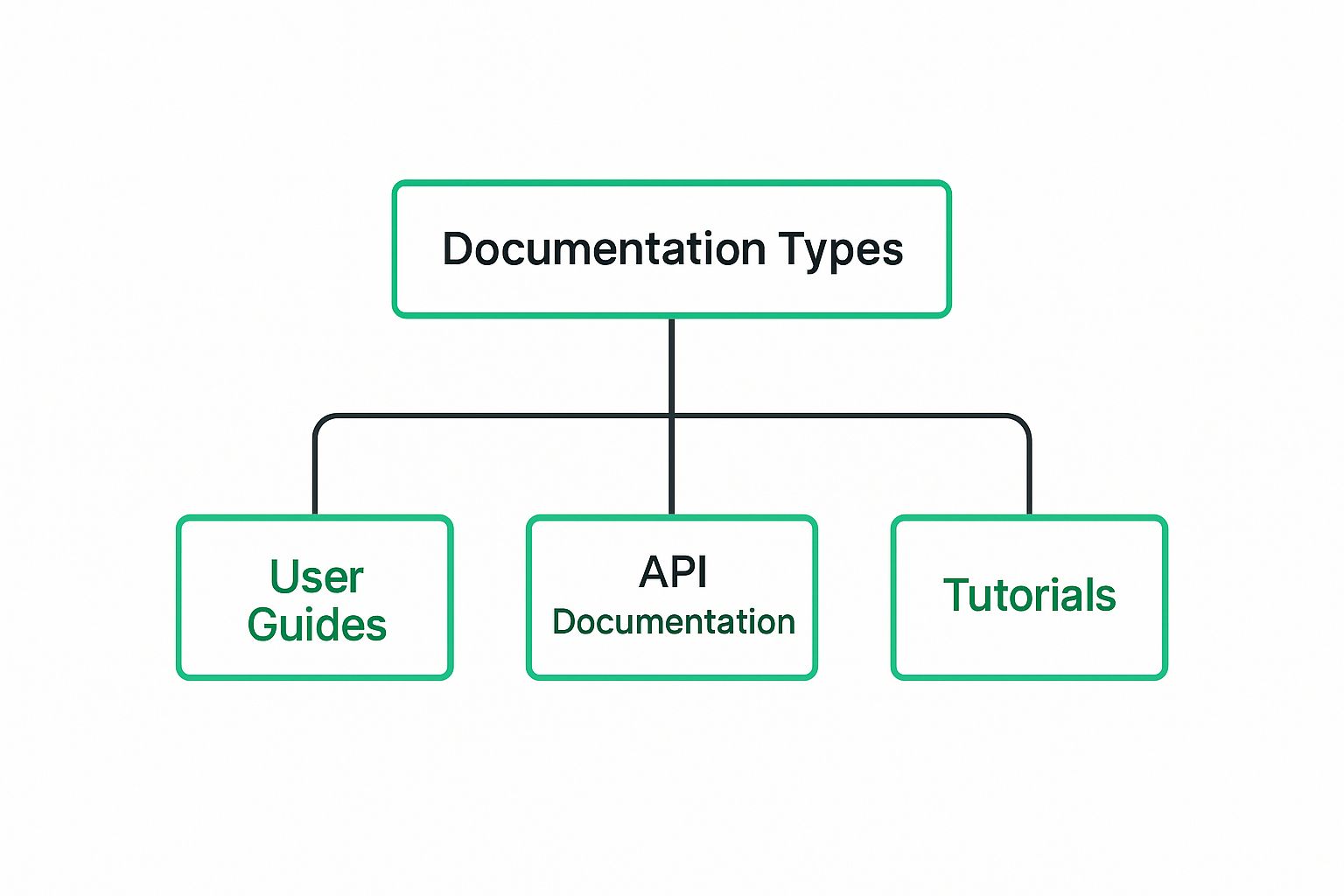Explore the different types of documentation, from internal system guides to external user manuals. Learn to choose the right format for any project.
Think of software documentation as the architectural blueprint for a building. Without a clear set of plans, the construction crew is just guessing, which almost always leads to structural flaws and a messy, inconsistent final product. It’s the same with software—without good documentation, projects descend into confusion, wasted effort, and a frustrating experience for everyone involved.
This blueprint isn’t a one-size-fits-all document. It’s a strategic asset that serves two completely different audiences with completely different needs.
First, you have your internal-facing documentation. This is for the people behind the curtain: the developers, engineers, and project managers who are actually building and maintaining the product. They need the nitty-gritty details—the technical specs, system architecture, and API references—to do their jobs, onboard new team members, and keep the project from falling apart over time. Finding the right balance between creating this detailed documentation and moving quickly is a constant challenge, especially in agile environments. We dive deeper into this in our guide on the documentation in agile development balancing act.
Then, you have your external-facing documentation. This is for the end-users, the customers who actually buy and use what you’ve built. They couldn’t care less about your elegant code or server setup. They just want to know how to use the product to solve their problems. Their documentation needs to be clear, easy to follow, and focused entirely on the user experience.
The diagram below breaks down how these different types of documentation fit together.

As you can see, it’s a branching structure where each type of document serves a specific purpose, from high-level user guides to deep technical references. Getting this structure right is the first step to creating a documentation strategy that actually works.
To give you a clearer picture of what’s ahead, let’s start with a quick summary of the main documentation categories we’ll be covering.
This table provides a high-level map for our journey. Now, let’s explore each of these categories in more detail.

While user-facing guides get most of the attention, the real unsung hero of any successful product is its system documentation. This is the internal blueprint, the highly detailed schematic that only your development and engineering teams will ever see.
Think of it this way: the end user gets the owner’s manual for their new car, but the mechanic gets the full engine schematics. System documentation is those schematics. It lays bare exactly how and why the product was built in the first place.
Without this crucial internal record, bringing a new developer onto the team becomes a slow, painful process of reverse-engineering existing code. Communication breaks down, wires get crossed, and the long-term health of your software is put at risk. Good system documentation is the very foundation of a scalable and maintainable product.
System documentation isn’t just one giant file. It’s a collection of different documents that, together, paint a complete picture of the system’s inner workings. Each piece serves a very specific purpose.
Some of the key formats you’ll find are:
So, how do all these pieces work together in the real world? Let’s imagine your team is building a new “user profile” feature for a mobile app.
The whole process kicks off with a requirements document. This document would specify that users must be able to upload a photo, edit their name, and change their password. Simple enough.
From there, an architecture document would map out how the app’s front end will communicate with the backend API to save this profile data securely in the database.
As your developers start writing the actual code, they’ll create API documentation for the endpoints that handle profile updates. For instance, they might document a PUT /api/v1/users/{id} endpoint, explaining its required parameters (like userName or newPassword) and what kind of responses to expect. This lets a frontend developer use the API without ever needing to dig through the backend code.
Finally, the QA team steps in. They’ll create test cases to verify that a user can successfully change their password, that invalid email formats are properly rejected, and that the profile photo uploads correctly. Every single part of this documentation trail is essential for building the feature right the first time and keeping it running smoothly in the future.

Once you’ve mapped out the software’s internal blueprints, it’s time to shift your focus from the creators to the people who will actually use it. User documentation is that friendly guide that welcomes customers and shows them how to get real value from your product, right out of the box.
Think of it as the clear, simple instruction manual you’d want for a new gadget, or the step-by-step setup wizard for a new app. It’s all about clarity and empowerment.
Unlike the dense, technical system documentation meant for developers, user-facing materials are all about empathy. The goal is to answer one simple question as quickly and painlessly as possible: “How do I do this?” Get this right, and you’ll dramatically reduce the load on your support team, make customers happier, and see product adoption skyrocket.
Great user documentation isn’t just one giant manual. It’s a whole library of resources, each designed for different learning styles and moments in a customer’s journey. From the first install to mastering advanced features, each format plays a specific role.
Here are the most common types you’ll see:
If you really want to level up your guides, exploring methods for creating effective video tutorials can be a game-changer. Sometimes, a quick visual walkthrough explains a complex process far better than pages of text ever could.
Building out these documents means getting inside your user’s head. It’s about translating what you know internally into simple, actionable advice. You have to anticipate their questions, understand their frustrations, and organize information in a way that just makes sense. For a much deeper look at this entire process, check out our complete guide to mastering software technical documentation.
Behind the scenes, how companies manage these documents is also evolving. The market for document management systems (DMS) is exploding, projected to hit $10.45 billion by 2025. This growth is being driven by new AI that can help sort and tag documents automatically and by real-time collaboration tools that plug right into platforms like Microsoft 365.
This internal efficiency is the secret sauce that keeps your customer-facing guides accurate and up-to-date, which is exactly what your users need.

It’s one thing to document your product, but what about documenting the business itself? This is where process documentation comes in. It’s the playbook that keeps your internal operations running smoothly, ensuring everyone is on the same page.
Think of it like the master recipe book in a five-star restaurant. Every single recipe is meticulously detailed so that a dish tastes exactly the same, whether the head chef or a sous-chef is making it. In the same way, process documentation standardizes your company’s workflows, guaranteeing tasks are done correctly and consistently every time.
This isn’t just about avoiding mistakes. It’s about turning that “tribal knowledge” locked away in a few key employees’ heads into a shared, reliable asset for the entire team.
Process documentation isn’t a single, monolithic document. It’s a whole collection of materials that, together, map out how your business functions day-to-day.
Here are the heavy hitters:
Getting your processes written down is the essential first step toward making them better. If you want to see how this plays out in the real world, check out these business process automation examples to see how standardized workflows can be supercharged.
The drive for clear process documentation is part of a much bigger picture: building more integrated and sustainable businesses. By 2025, companies aren’t just digitizing workflows for speed; they’re doing it to shrink their environmental footprint.
Moving away from paper-based systems drastically cuts down on paper waste, energy use, and emissions. This often ties into a larger strategy where document management systems are hooked into other core platforms like ERP and CRM software, creating a seamless flow of information that’s both efficient and eco-friendly.
Knowing the different types of documentation is one thing, but actually creating content that people find useful is a whole different ballgame. Great documentation doesn’t just happen by accident. It’s the result of a disciplined approach focused on making your content clear, findable, and trustworthy.
The absolute first principle is to deeply understand your audience. A guide written for a senior engineer will look completely different from one meant for a non-technical customer. Before you type a single word, you have to ask yourself:
Answering these questions first helps you write content that speaks directly to your reader’s needs, cutting out the fluff and preventing a whole lot of frustration. This empathetic mindset is the bedrock of all good documentation. Our detailed guide on writing technical documentation dives even deeper into this.
Have you ever read a help guide where every page felt like it was written by a different person? It’s jarring. A consistent voice, tone, and format across all your documents create a much more professional and predictable experience for your users.
Your best friend here is a style guide. It sets the rules for everything from the terms you use to how you format code snippets. This simple tool prevents the “too many cooks in the kitchen” problem, where different authors create a confusing mess of content.
And don’t forget visuals. A well-placed screenshot, diagram, or flowchart can often explain a tricky concept much better than paragraphs of text ever could. Anything you can do to make the information easier to digest is a win. For more on this, check out these expert tips on taking better meeting notes, as the principles of clarity apply everywhere.
Let’s be honest: outdated documentation is worse than having no documentation at all. It misleads people, creates bad habits, and completely erodes confidence in your product.
The only way to fight this is to bake documentation updates directly into your development process. When a feature changes, the documentation must change with it. No exceptions.
Finally, even the best documentation is useless if nobody can find it. You need a powerful search function and a logical, intuitive way of organizing everything. This is getting a lot easier with modern tools. For example, the Intelligent Document Processing (IDP) market is expected to hit $17.8 billion by 2032, largely because AI is getting so good at automatically classifying information and making it searchable. These technologies are fundamentally changing how we manage all the different types of documentation.
As you start thinking about all these different types of documentation, a few practical questions almost always pop up. Let’s tackle some of the most common ones I hear.
This is the big one, and the honest answer is: there isn’t one. The “most important” type of documentation is completely relative. It all comes down to who’s asking and what they need to get done.
Think about it this way: for a dev team in the trenches building a new feature, nothing is more critical than solid system documentation like architecture diagrams and API specs. They simply can’t work without it.
But for the customer who just bought that feature? They don’t care about the architecture. They need user documentation—a clear tutorial or a quick-start guide to get them going. Meanwhile, a project manager trying to keep a massive, sprawling organization on the same page will swear that process documentation, like their Standard Operating Procedures (SOPs), is the most valuable thing in the world.
The real magic happens when you stop looking for a silver bullet and see how all these pieces fit together. Each type serves a unique, vital purpose in the grander scheme of things.
Ah, the age-old problem of documentation decay. We’ve all seen it: guides that are hopelessly out of date, making them more confusing than helpful. Keeping your docs fresh isn’t about good intentions; it requires a real system.
Here’s how you can stop the rot before it starts:
At their core, the main difference boils down to one thing: the audience. Who are you writing for? This single question changes everything—the language you use, the details you include, and the entire purpose of the document.
Technical documentation is for the people behind the curtain: developers, engineers, and sysadmins. It’s all about the how and why of the system itself—its architecture, its code, its APIs. The goal is to give them the blueprints they need to build on, maintain, or integrate with your system. It’s supposed to be technical and full of jargon because that’s the language the audience speaks. A detailed API reference is a perfect example.
User documentation, on the other hand, is for the end-user—the person who just wants to get something done. Its job is to explain how to use the product to solve a problem. It sticks to simple language, focuses on practical steps, and avoids technical deep dives. Think of a “Getting Started” guide or a simple troubleshooting FAQ.
It’s really that simple: one is about how the product is built, and the other is about how the product is used.